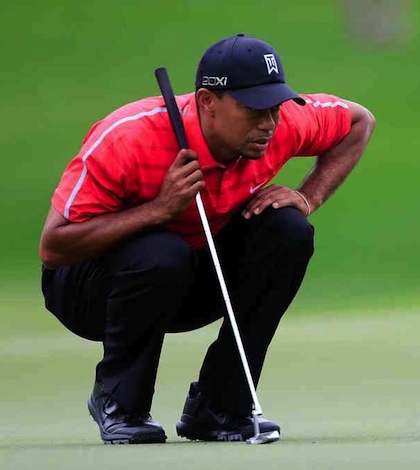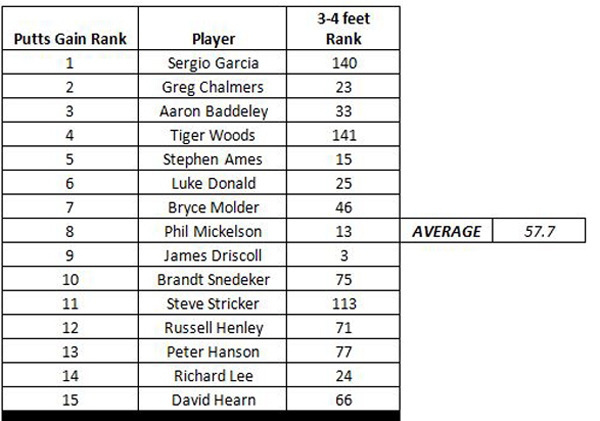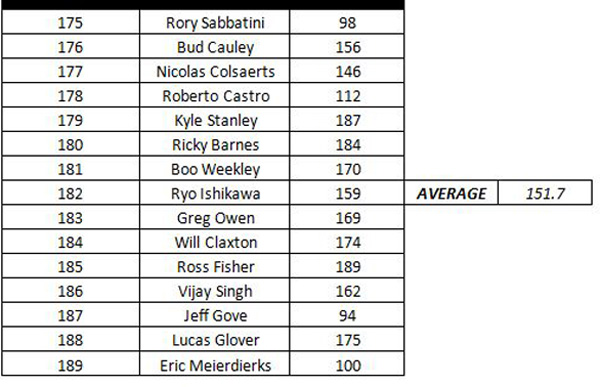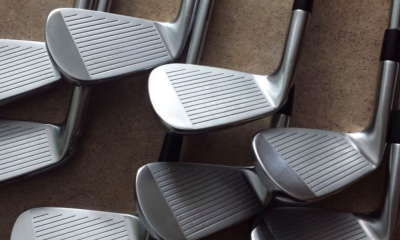Opinion & Analysis
The most important putts to make

Back in May, I felt that Tiger Woods was Statistically Primed For the U.S. Open.
Tiger had just come off his fourth victory for the year, and was using a very conservative tee shot strategy — hitting a lot of 3 woods and 5 woods off tees where most of his competitors were hitting driver.
All of the research I have conducted actually states that a conservative tee shot strategy is usually a bad idea, and that leaving the driver in the bag should be a golfer’s very last option, not his first or second option. But, my reasoning was that since Merion would force a lot of lay-up shots off the tee and that nobody was better at laying up off the tee than Tiger, he was in prime position to win his fourth U.S. Open.
However, there was something that made me a little uncomfortable about forecasting Tiger’s success for the U.S. Open. For most of the first half of the season he was by far and away the best putter on the PGA Tour from outside 15 feet. And all the research I have done has shown that Tour players will move toward the means on putts from outside 15 feet regardless of their putting skill level. I feel that this important information for amateurs to understand in order to not only putt better, but to better plan their shots.
The gold standard for putting metrics is Strokes Gained – Putting. The concept is simple: It calculates the distance of the putt and what the average number of putts for the field have been from that distance. Then it takes the number of putts the golfer makes and subtracts it from the field average.
For example, if a golfer two-putts from 40 feet and the field average from 40 feet for the tournament is at 2.183 strokes, then the golfer gained 0.183 strokes on the field from that particular distance of putt. If the golfer three-putts, then they lost -0.817 strokes to the field on that putt.
What I found was that the distance range of putts that correlates most strongly to Strokes Gained — Putting are putts from 3 to 15 feet. Here is the list of the current top-15 golfers in Strokes Gained — Putting and how they rank on putts from various distances.
The table shows that not only do these top putters tend to rank much better on putts from 3 to 15 feet than on putts longer than 15 feet, but the standard deviation shows much more variance in the rankings as the putts get longer. Sergio Garcia is ranked No. 1 in putts from more than 25 feet and in Strokes — Gained Putting. However, this is merely an anomaly and goes to show how there is little rhyme or reason as to what golfers will make putts from longer than 15 feet.
Here’s a line chart that hopefully illustrates the point a little better.
I call the percentage of putts made from longer than 15 feet a “volatile metric.” What I mean is that a player may rank high in putts made from greater than 15 feet one season, and then rank low on putts made from greater than 15 feet the very next season. It does not matter if the golfer is generally a “great putter” or a “bad putter.”
Here’s a few examples using typically “great putters” (Baddeley, Donald and Snedeker) versus typically “bad putters” (Weekley, Garrigus and Stadler) on putts from longer than 15 feet over the years.
The table further demonstrates the volatility on making putts from longer than 15 feet. Luke Donald has been the greatest putter on Tour during the past five years, and he has had some years where he has made a high percentage of putts from longer than 15 feet and other years where he has struggled from this distance. Conversely, Boo Weekley has been one of the worst putters on Tour in the past five years and he has had some years where he has made a lot of long putts and in other years he has struggled from longer distances.
The data shows that making putts from outside 15 feet has more to do with luck, while making putts from inside 15 has more to do with skill. Thus, for golfers looking to learn from this, they should spend more of their time practicing putts from 3 to 15 feet than putts longer than 15 feet.
However, if I want to go into more finite detail, the strongest correlation of putts made from a one-foot distance range and putts gained is putts from 3 to 4 feet. This is particularly telling when we look at the rankings of the top and bottom-15 players in Strokes Gained — Putting and their rankings in putts from 3 and 4 feet.
I believe that the reason for the strong correlation on these 3- to 4-foot putts and Strokes Gained — Putting is because a putt from 3 to 4 feet is very makeable, but just difficult enough where golfers can easily miss. I believe that these putts require the basic fundamentals to good putting in the golfer’s ability to aim properly, the centeredness of contact and having the right amount of touch and speed on the putt. I also feel it requires a sharp eye for green reading.
While most putts from 3 to 4 feet have little or no break to them, the golfer has to correctly identify that small break when it is there. And again, we should note that Sergio (and Tiger) are mere anomalies as the average ranking for these top-15 putters from 3 to 4 feet is typically in the top-50.
Thus, I recommend golfers not only focus their practice toward putts from inside 15 feet, but to spend a little extra time on those 3 to 4 footers in order to get the fundamentals of putting.
But, that’s not all that the data shows. Another key metric is that current average on Tour is for a golfer to make one birdie putt from outside 15 feet for every 36.2 holes of golf he plays. In essence, it will take a little over two rounds before the average Tour player will make a birdie putt longer than 15 feet.
Thus, if golfers want to make more birdies, they need to strive to get more birdie putts inside 15 feet rather than hope that they can make a few long putts outside of 15 feet. This is what happens in EVERY super-low round on Tour. The player simply accumulates a lot of birdie opportunities. For instance, Tiger’s 61 at Firestone included nine birdie opportunities from inside 15 feet in which Tiger converted eight of them.
For golfers looking to shoot better scores by improving their putting, focus on making more putts from inside 15 feet. And if you’re looking to make substantial improvements to your score, accumulate more birdie opportunities inside 15 feet. For the higher handicappers, I suggest continuing to work on putting from inside 15 feet and to try to accumulate more par opportunities from inside 15 feet.
- LIKE3
- LEGIT0
- WOW0
- LOL0
- IDHT0
- FLOP0
- OB0
- SHANK0
19th Hole
Vincenzi’s LIV Golf Singapore betting preview: Course specialist ready to thrive once again

After another strong showing in Australia, LIV Golf will head to Sentosa Golf Club in Singapore looking to build off of what was undoubtedly their best event to date.
Sentosa Golf Club sits on the southern tip of Singapore and is one of the most beautiful courses in the world. The course is more than just incredible scenically; it was also rated 55th in Golf Digest’s top-100 courses in 2022-2023 and has been consistently regarded as one of the best courses in Asia. Prior to being part of the LIV rotation, the course hosted the Singapore Open every year since 2005.
Sentosa Golf Club is a par 71 measuring 7,406 yards. The course will require precise ball striking and some length off the tee. It’s possible to go low due to the pristine conditions, but there are also plenty of hazards and difficult spots on the course that can bring double bogey into play in a hurry. The Bermudagrass greens are perfectly manicured, and the course has spent millions on the sub-air system to keep the greens rolling fast. I spoke to Asian Tour player, Travis Smyth, who described the greens as “the best [he’s] ever played.”
Davis Love III, who competed in a Singapore Open in 2019, also gushed over the condition of the golf course.
“I love the greens. They are fabulous,” the 21-time PGA Tour winner said.
Love III also spoke about other aspects of the golf course.
“The greens are great; the fairways are perfect. It is a wonderful course, and it’s tricky off the tee.”
“It’s a long golf course, and you get some long iron shots. It takes somebody hitting it great to hit every green even though they are big.”
As Love III said, the course can be difficult off the tee due to the length of the course and the trouble looming around every corner. It will take a terrific ball striking week to win at Sentosa Golf Club.
In his pre-tournament press conference last season, Phil Mickelson echoed many of the same sentiments.
“To play Sentosa effectively, you’re going to have a lot of shots from 160 to 210, a lot of full 6-, 7-, 8-iron shots, and you need to hit those really well and you need to drive the ball well.”
Golfers who excel from tee to green and can dial in their longer irons will have a massive advantage this week.
Stat Leaders at LIV Golf Adelaide:
Fairways Hit
1.) Louis Oosthuizen
2.) Anirban Lahiri
3.) Jon Rahm
4.) Brendan Steele
5.) Cameron Tringale
Greens in Regulation
1.) Brooks Koepka
2.) Brendan Steele
3.) Dean Burmester
4.) Cameron Tringale
5.) Anirban Lahiri
Birdies Made
1.) Brendan Steele
2.) Dean Burmester
3.) Thomas Pieters
4.) Patrick Reed
5.) Carlos Ortiz
LIV Golf Individual Standings:
1.) Joaquin Niemann
2.) Jon Rahm
3.) Dean Burmester
4.) Louis Oosthuizen
5.) Abraham Ancer
LIV Golf Team Standings:
1.) Crushers
2.) Legion XIII
3.) Torque
4.) Stinger GC
5.) Ripper GC
LIV Golf Singapore Picks
Sergio Garcia +3000 (DraftKings)
Sergio Garcia is no stranger to Sentosa Golf Club. The Spaniard won the Singapore Open in 2018 by five strokes and lost in a playoff at LIV Singapore last year to scorching hot Talor Gooch. Looking at the course setup, it’s no surprise that a player like Sergio has played incredible golf here. He’s long off the tee and is one of the better long iron players in the world when he’s in form. Garcia is also statistically a much better putter on Bermudagrass than he is on other putting surfaces. He’s putt extremely well on Sentosa’s incredibly pure green complexes.
This season, Garcia has two runner-up finishes, both of them being playoff losses. Both El Camaleon and Doral are courses he’s had success at in his career. The Spaniard is a player who plays well at his tracks, and Sentosa is one of them. I believe Sergio will get himself in the mix this week. Hopefully the third time is a charm in Singapore.
Paul Casey +3300 (FanDuel)
Paul Casey is in the midst of one of his best seasons in the five years or so. The results recently have been up and down, but he’s shown that when he’s on a golf course that suits his game, he’s amongst the contenders.
This season, Casey has finishes of T5 (LIV Las Vegas), T2 (LIV Hong Kong), and a 6th at the Singapore Classic on the DP World Tour. At his best, the Englishman is one of the best long iron players in the world, which makes him a strong fit for Sentosa. Despite being in poor form last season, he was able to fire a Sunday 63, which shows he can low here at the course.
It’s been three years since Casey has won a tournament (Omega Dubai Desert Classic in 2021), but he’s been one of the top players on LIV this season and I think he can get it done at some point this season.
Mito Pereira +5000 (Bet365)
Since Mito Pereira’s unfortunate demise at the 2022 PGA Championship, he’s been extremely inconsistent. However, over the past few months, the Chilean has played well on the International Series as well as his most recent LIV start. Mito finished 8th at LIV Adelaide, which was his best LIV finish this season.
Last year, Pereira finished 5th at LIV Singapore, shooting fantastic rounds of 67-66-66. It makes sense why Mito would like Sentosa, as preeminent ball strikers tend to rise to the challenge of the golf course. He’s a great long iron player who is long and straight off the tee.
Mito has some experience playing in Asia and is one of the most talented players on LIV who’s yet to get in the winner’s circle. I have questions about whether or not he can come through once in contention, but if he gets there, I’m happy to roll the dice.
Andy Ogletree +15000 (DraftKings)
Andy Ogletree is a player I expected to have a strong 2024 but struggled early in his first full season on LIV. After failing to crack the top-25 in any LIV event this year, the former U.S. Amateur champion finally figured things out, finished in a tie for 3rd at LIV Adelaide.
Ogletree should be incredible comfortable playing in Singapore. He won the International Series Qatar last year and finished T3 at the International Series Singapore. The 26-year-old was arguably the best player on the Asian Tour in 2023 and has been fantastic in the continent over the past 18 months.
If Ogletree has indeed found form, he looks to be an amazing value at triple-digit odds.
- LIKE3
- LEGIT3
- WOW1
- LOL2
- IDHT0
- FLOP2
- OB0
- SHANK0
Opinion & Analysis
Ryan: Lessons from the worst golf instructor in America

In Tampa, there is a golf course that boasts carts that do not work, a water range, and a group of players none of which have any chance to break 80. The course is overseen by a staff of crusty men who have succeeded at nothing in life but ending up at the worst-run course in America. However, this place is no failure. With several other local courses going out of business — and boasting outstanding greens — the place is booked full.
While I came for the great greens, I stayed to watch our resident instructor; a poor-tempered, method teacher who caters to the hopeless. At first, it was simply hilarious. However, after months of listening and watching, something clicked. I realized I had a front-row seat to the worst golf instructor in America.
Here are some of my key takeaways.
Method Teacher
It is widely accepted that there are three types of golf instructors: system teachers, non-system teachers, and method teachers. Method teachers prescribe the same antidote for each student based on a preamble which teachers can learn in a couple day certification.
Method teaching allows anyone to be certified. This process caters to the lowest caliber instructor, creating the illusion of competency. This empowers these underqualified instructors with the moniker of “certified” to prey on the innocent and uninformed.
The Cult of Stack and Jilt
The Stack and Tilt website proudly boasts, “A golfer swings his hands inward in the backswing as opposed to straight back to 1) create power, similar to a field goal kicker moving his leg in an arc and 2) to promote a swing that is in-to-out, which produces a draw (and eliminates a slice).”
Now, let me tell you something, there is this law of the universe which says “energy can either be created or destroyed,” so either these guys are defying physics or they have no idea what they are taking about. Further, the idea that the first move of the backswing determines impact is conjecture with a splash of utter fantasy.
These are the pontifications of a method — a set of prescriptions applied to everyone with the hope of some success through the placebo effect. It is one thing for a naive student to believe, for a golf instructor to drink and then dispel this Kool-Aid is malpractice.
Fooled by Randomness
In flipping a coin, or even a March Madness bet, there is a 50-50 chance of success. In golf, especially for new players, results are asymmetric. Simply put: Anything can happen. The problem is that when bad instructors work with high handicappers, each and every shot gets its own diagnosis and prescription. Soon the student is overwhelmed.
Now here’s the sinister thing: The overwhelming information is by design. In this case, the coach is not trying to make you better, they are trying to make you reliant on them for information. A quasi Stockholm syndrome of codependency.
Practice
One of the most important scientists of the 20th century was Ivan Pavlov. As you might recall, he found that animals, including humans, could be conditioned into biological responses. In golf, the idea of practice has made millions of hackers salivate that they are one lesson or practice session from “the secret.”
Sunk Cost
The idea for the worst golf instructor is to create control and dependency so that clients ignore the sunk cost of not getting better. Instead, they are held hostage by the idea that they are one lesson or tip away from unlocking their potential.
Cliches
Cliches have the effect of terminating thoughts. However, they are the weapon of choice for this instructor. Add some hyperbole and students actually get no information. As a result, these players couldn’t play golf. When they did, they had no real scheme. With no idea what they are doing, they would descend into a spiral of no idea what to do, bad results, lower confidence, and running back to the lesson tee from more cliches.
The fact is that poor instruction is about conditioning players to become reliant members of your cult. To take away autonomy. To use practice as a form of control. To sell more golf lessons not by making people better but through the guise that without the teacher, the student can never reach their full potential. All under the umbrella of being “certified” (in a 2-day course!) and a melee of cliches.
This of course is not just happening at my muni but is a systemic problem around the country and around the world, the consequences of which are giving people a great reason to stop playing golf. But hey, at least it’s selling a lot of golf balls…
- LIKE15
- LEGIT1
- WOW0
- LOL4
- IDHT1
- FLOP0
- OB0
- SHANK14
19th Hole
Vincenzi’s 2024 Zurich Classic of New Orleans betting preview

The PGA TOUR heads to New Orleans to play the 2023 Zurich Classic of New Orleans. In a welcome change from the usual stroke play, the Zurich Classic is a team event. On Thursday and Saturday, the teams play best ball, and on Friday and Sunday the teams play alternate shot.
TPC Louisiana is a par 72 that measures 7,425 yards. The course features some short par 4s and plenty of water and bunkers, which makes for a lot of exciting risk/reward scenarios for competitors. Pete Dye designed the course in 2004 specifically for the Zurich Classic, although the event didn’t make its debut until 2007 because of Hurricane Katrina.
Coming off of the Masters and a signature event in consecutive weeks, the field this week is a step down, and understandably so. Many of the world’s top players will be using this time to rest after a busy stretch.
However, there are some interesting teams this season with some stars making surprise appearances in the team event. Some notable teams include Patrick Cantlay and Xander Schauffele, Rory McIlroy and Shane Lowry, Collin Morikawa and Kurt Kitayama, Will Zalatoris and Sahith Theegala as well as a few Canadian teams, Nick Taylor and Adam Hadwin and Taylor Pendrith and Corey Conners.
Past Winners at TPC Louisiana
- 2023: Riley/Hardy (-30)
- 2022: Cantlay/Schauffele (-29)
- 2021: Leishman/Smith (-20)
- 2019: Palmer/Rahm (-26)
- 2018: Horschel/Piercy (-22)
- 2017: Blixt/Smith (-27)
2024 Zurich Classic of New Orleans Picks
Tom Hoge/Maverick McNealy +2500 (DraftKings)
Tom Hoge is coming off of a solid T18 finish at the RBC Heritage and finished T13 at last year’s Zurich Classic alongside Harris English.
This season, Hoge is having one of his best years on Tour in terms of Strokes Gained: Approach. In his last 24 rounds, the only player to top him on the category is Scottie Scheffler. Hoge has been solid on Pete Dye designs, ranking 28th in the field over his past 36 rounds.
McNealy is also having a solid season. He’s finished T6 at the Waste Management Phoenix Open and T9 at the PLAYERS Championship. He recently started working with world renowned swing coach, Butch Harmon, and its seemingly paid dividends in 2024.
Keith Mitchell/Joel Dahmen +4000 (DraftKings)
Keith Mitchell is having a fantastic season, finishing in the top-20 of five of his past seven starts on Tour. Most recently, Mitchell finished T14 at the Valero Texas Open and gained a whopping 6.0 strokes off the tee. He finished 6th at last year’s Zurich Classic.
Joel Dahmen is having a resurgent year and has been dialed in with his irons. He also has a T11 finish at the PLAYERS Championship at TPC Sawgrass which is another Pete Dye track. With Mitchell’s length and Dahmen’s ability to put it close with his short irons, the Mitchell/Dahmen combination will be dangerous this week.
Taylor Moore/Matt NeSmith +6500 (DraftKings)
Taylor Moore has quickly developed into one of the more consistent players on Tour. He’s finished in the top-20 in three of his past four starts, including a very impressive showing at The Masters, finishing T20. He’s also finished T4 at this event in consecutive seasons alongside Matt NeSmith.
NeSmith isn’t having a great 2024, but has seemed to elevate his game in this format. He finished T26 at Pete Dye’s TPC Sawgrass, which gives the 30-year-old something to build off of. NeSmith is also a great putter on Bermudagrass, which could help elevate Moore’s ball striking prowess.
- LIKE8
- LEGIT3
- WOW1
- LOL1
- IDHT0
- FLOP3
- OB1
- SHANK2
-

 19th Hole1 week ago
19th Hole1 week agoJustin Thomas on the equipment choice of Scottie Scheffler that he thinks is ‘weird’
-

 19th Hole1 week ago
19th Hole1 week ago‘Absolutely crazy’ – Major champ lays into Patrick Cantlay over his decision on final hole of RBC Heritage
-

 19th Hole2 weeks ago
19th Hole2 weeks agoTwo star names reportedly blanked Jon Rahm all week at the Masters
-

 19th Hole2 weeks ago
19th Hole2 weeks agoReport: LIV Golf identifies latest star name they hope to sign to breakaway tour
-

 19th Hole2 weeks ago
19th Hole2 weeks agoNeal Shipley presser ends in awkward fashion after reporter claims Tiger handed him note on 8th fairway
-

 19th Hole2 weeks ago
19th Hole2 weeks agoBrandel Chamblee has ‘no doubt’ who started the McIlroy/LIV rumor and why
-

 Equipment3 weeks ago
Equipment3 weeks agoWhat we know about Bryson DeChambeau’s 3D-printed Avoda irons
-

 19th Hole6 days ago
19th Hole6 days agoLET pro gives detailed financial breakdown of first week on tour…and the net result may shock you



































td
Aug 17, 2013 at 10:37 am
…” I believe that these putts require the basic fundamentals to good putting in the golfer’s ability to aim properly, the centeredness of contact and having the right amount of touch and speed on the putt. I also feel it requires a sharp eye for green reading.”
Is that you Tim Mccarver!?!?
t120
Aug 20, 2013 at 1:37 am
…funniest baseball comment in a non-baseball thread I’ve ever read.
Tim
Aug 17, 2013 at 7:25 am
Great analysis! I really appreciate the data crunching you did to support your recommendations. I look forward to reading more and to getting the e-book.
Bob
Aug 16, 2013 at 4:50 pm
Sooooo hit the ball closer to the hole and make more putts? Who woooda thunk it!
Richie Hunt
Aug 22, 2013 at 1:34 pm
Bob,
That wasn’t the point of the article. The point is that the *most important putts to make* are putts from inside 15 feet. Mainly because making putts from longer than 15 feet come down to luck and randomness, regardless of your putting skill. Obviously, we will make less putts as we get further away from the hole, but the best putters that ‘gain the most strokes’ on the greens do it by making more putts inside 15 feet than their competition.
steff
Aug 16, 2013 at 4:15 am
Great article Rich! I did not agree with your last article but this is spot on!
This year i have improoved my putting a lot. I´ve practiced a lot from 4 feet. I have a drill where i putt 8 tees around the hole and putt 4 balls from each tee. I do this before evry competative round. I´ve gone from 25/32 to around 30 evry time!
This have resulted in lowering my average score a lot but not lowered my best scores (yet).
Next up is 6-7 feet. With the same drill i usuly score around 15-20 out of 32.
Pat
Aug 15, 2013 at 7:13 pm
All I learned from this is that if Luke Donald could make something outside 15 feet he’d be pretty good.
Richie Hunt
Aug 16, 2013 at 9:06 am
Well, he’s pretty good to start with. It just means that Luke is likely to progress towards the mean from outside 15 feet pretty soon. Luke’s biggest weakness is his driving. And lately he has struggled on some of his longer approach shots.
Steve
Aug 15, 2013 at 7:07 pm
Where do you access all of your source data? I’d be very interested in rooting through the data.
Thanks,
Rich Hunt
Aug 15, 2013 at 3:00 pm
Geoff,
The research I’ve done is based on years of work. I just used this year’s current data as an example. Generally 5-10 foot putts are about as important as 10-15 footers. This year there is a bit of an exception as the top players in Putts Gained are putting quite well from 5-10 feet. However, I expect that to regress more towards the 10-15 footers.
I generally recommend golfers that are struggling to work on 3-4 footers first. Then move to 5-10 footers. Then 10-15 footers.
Hope this helps.
Geoff S
Aug 15, 2013 at 2:45 pm
Maybe I’m missing something here, but the 10-15′ foot putts don’t appear to be as important as < 10' putts. The 5-10' ranks of the top putters is pretty impressive.
I agree on your thesis though. Without question the more practice I put into 5'-15' putts, the better my scores get each round.